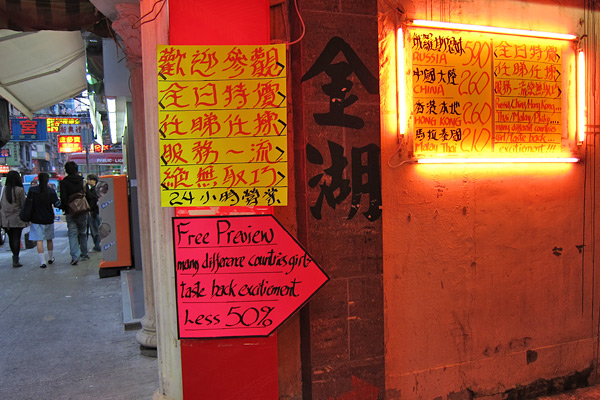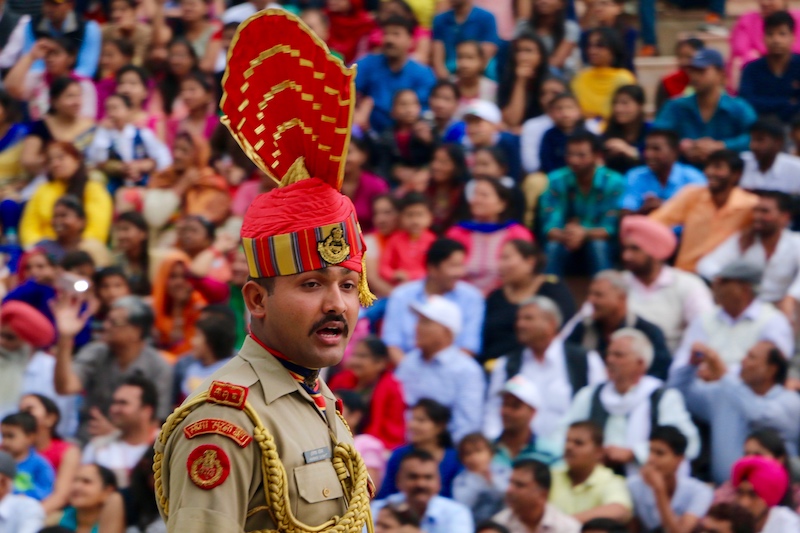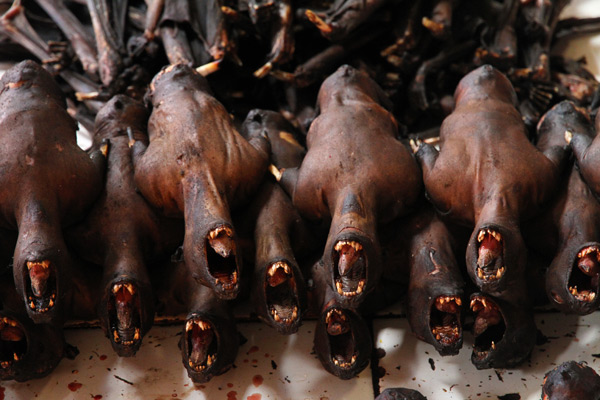Wicked places in Asia
China
Red-light districts in Hong Kong 
Wan Chai (Lockhart Road) and Mong Kok (Portland street), Hong Kong
During the Vietnam War, Hong Kong was a favoured place for R&R (rest and recuperation) for American soldiers, and before them, the sailors got boozed-up in Wan Chai district in downtown Hong Kong. Like other R&R places (like Singapore, Tokyo and Taipei) Hong Kong has pulled its act together. Today, the bars in Wan Chai are mostly drinking pubs with the occasional bargirl, while the red-light district has moved to other parts, like Mong Kok across the bay, and has become less obvious. The only thing you see from the street are signs offering girls of any colour.
Walking down the street of Chaowai Shichang feels like travelling through space. Cyrillic script, bleached Caucasians women in way too tight clothes and Russian words, even the Chinese vendors speak to you in Russian. You have entered the area of the Russian markets. Since the time of communism, the people of the red states could only visit each other, so in every red capital (Beijing, Phnom Penh, Hanoi,...) so-called Russian markets sprung up to cater for the Russian tourists. Today, the Beijing version has expanded to more than just a market, it is now a collection of malls filled with what Russians apparently want. Anything made of fur, with high heels, or that makes you look like a call girl can be found here. The shops are strangely hidden by curtains and posters of skimpily dressed Russian models, so window browsing is obviously not a big thing for the Russian customers. Go there for the weird factor.
Under the broad boulevards of Beijing exists a system of tunnels that Chairman Mao ordered to be dug out in the late 1970's in the event of a Russian attack. The whole system should be longer than the Chinese wall (5000 km) and some parts wide enough for the Chairman's limo. It seems that these tunnels are long forgotten by the Chinese themselves, and rumours are that Chinese tourists are not even allowed in them. More the reason to visit them, if not for the history then just for the absurdity of them.
It's no secret that Kashmir has had its troubled times in the past. So one would not really expect this to be the place to come for a bit of calm and relaxation; this is especially the case if you stay on a houseboat in Srinagar. Simple but comfortable floating trailers line the shores of local lakes only a hop, skip and a jump from the busy downtown. Many of the houseboats are wonderfully decorated with local arts & crafts including incredibly intricate woodwork (walnut) and paper mâché. Perhaps best of all, you can choose the lake experience which best suits you. Dal Lake is the busy lake with Shikaras (local boats) ferrying passengers to & fro, or you could opt for the more tranquil Nigeen Lake. Either way, staying on a houseboat is a great opportunity to have your worry float away.
Temples are pretty. Elephant rides are fun. Holy baths are wet. India's full of such experiences. But there comes a time where you just can't motivate yourself to see yet another temple or elephant or bath. Sometimes you need something completely different and unique. Look no further than Nek Chand's Rock Garden in Chandigarh. What started off as a basic garden initiative has become a eclectic artist's paradise of waterfalls, sculpture and murals made entirely of industrial and home waste and thrown-away items. The maze of alleyways hide the massiveness of the place spreading over some 40 acres. Easily one of the weirdest places not only in India, but the world.
We've all seen those changing of the guard ceremonies where some traditionally dressed guards perform a simple dance-like show while pretending to guard a building or monument that nobody's going to attack. But the flag-lowering ceremony at the Wagah border crossing between India and Pakistan is anything but ceremonial. These are two countries with a long history of not getting along. Blood has been spilt. Yet every afternoon, around sunset, the 2 sides participate is a show of one-upmanship by graduates of Monty Python's Ministry of Silly walks. The crowds get into it as if it were the World Cup final. It's a party wrapped in a ceremony shrouded in hatred. An absolute not miss!!
Often sold as tickets to the moon, magic mushroom are easy available throughout backpacker Indonesia. Though mushrooms are illegal throughout Indonesia some backpacker places seem to be going under the radar. Seeing billboards advertising "Bloody sexy fresh magic mushrooms" are not unusual in places like the Gili Islands. So if you do want a trip to the moon, just make sure it is a return ticket you get.
Tomohon town lies between two volcanoes at the altitude of around 800 m. Due to the fertile soil and the temperate climate, the local market is flooded with spices, fruits, and vegetables - but it's not the only thing the market is known for. The meat section is a slaughter house full of local specialties, like wild boars, rats, civets (or are they cats), bats (pictured), snakes, and dogs. There are blood everywhere and often bits of meat fly off the fast cutting knives. Most of the animal are already dead, but dogs are sometimes kept alive in cages until sold. They are then killed with a knock to the head, blow torched, and chopped into pieces suited for a shopping bag – it's not a sight for the fainthearted. The stall owners are friendly and don't mind a curious traveller, but leave your opinion about animal rights at home.
Cafes with live pets are getting popular in the bigger cities in Japan. Most of the cafes have ordinary pets like cats, dogs or rabbits, but some have more unusual animals like otters, hedgehogs and owls (picture). The price depends on the time spend and a softdrink is usually included. The cafe owners seem to keep the pets on a rotation schedule, so the animals don't get (too) stressed of all the attention.
In general, premium fruits are expensive in Japan, particularly if they are locally grown. Exceptional specimens are often sold as gift items for extreme high prices. One of the more unusual fruits are the square watermelons, which are domestic farmed in square-shaped molds, so they better fit in the fridge. The watermelons in the picture costs 13,000 yen (120 USD), which is among the cheaper ones. Other expensive locally grown fruits are black watermelons (about 25,000 yen) and muskmelons (about 10,000 yen) from Hokkaido and mangos from Kyushu (about 2,500 yen).











